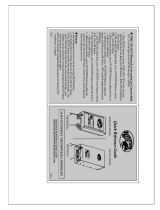
Installation, Mounting
Page 8
Location of cabinets
• Cabinets generate heat (see table below). Make sure they are mounted in a conditioned
space where the temperature will be 0-40
o
C (32-104
o
F)
• Reinforce the wall for strength as required for weight and local code
• Clearance on left and right side of the panel should be maintained at 1
1
/
2
" or greater
• Relays will click while in operation. Please locate the panels where audible noise is
acceptable.
Mounting Cabinet
Step 1: Locate where the cabinet will be hung on the wall. Choose a location in a dry area
that is convenient to the branch circuit panel.
Step 2: Leviton recommends that cabinet mounting hardware reach through the drywall
and attaches to wall studs or other suitable solid backing. However, properly
sized struts and suitable drywall hardware can also be used. They must distribute
the load to the anchors without exceeding the recommended anchor limit. Using
drywall screws directly through drywall without a stud is not recommended. Make
sure that there is adequate support
Step 3: Loosen the (4) cover screws and remove the cover by sliding the cover up and off.
Appropriately store the cover for future use.
Step 4: Locate the mounting plate assembly attached to the back wall of the enclosure.
Locate the 4 mounting screws in the 4 corners of the rear plate. Loosen these 4
screws. Lift the entire electrical assembly up and out of the enclosure. Do not
attempt to remove the keyboard separately from its mounting bracket. Store the
assembly in a protected, clean, dry place. Tighten the 4 screws so they don't get
lost.
Step 5: Prior to proceeding, reference the figures below which show the location of the
mounting holes and allowed conduit entry locations.
Step 6: Orient the enclosure so that the "UP" arrow on the label inside the enclosure is
pointing up. Note that the high-voltage conduit access is through the right end of
the bottom, the right side and the right end of the top. Note that the low-voltage
(Class 2) conduit access is through the top end of the left side and the left end of
the top. Cut or punch the desired conduit openings. Do not cut openings in the
back of the enclosure or the bottom end of the left side or the left end of the
bottom as it will no longer be possible to re-install the electrical assembly.
Step 7: Mount to a substantial indoor vertical surface with hardware supplied by others
through the 4 - 0.24 holes in the back wall for #10 hardware. The enclosure is
Type 1 for indoor use only
Cabinet Suggested Mounting height to bottom of
cabinet
4 Relay Panel 62" (157 cm)
Cabinet MAX BTU/HR
4 Relay Cabinet 97




















